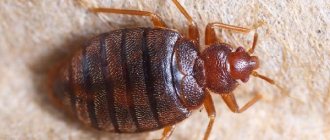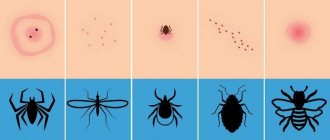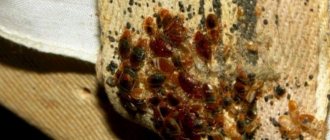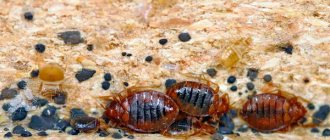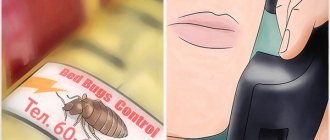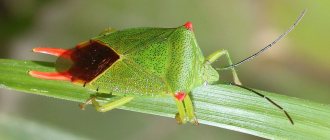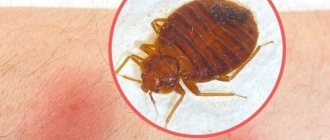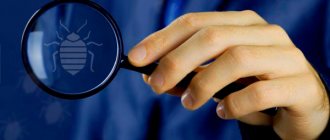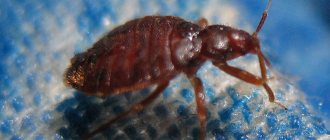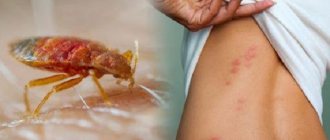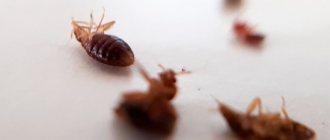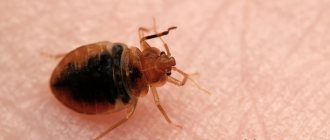In today's conditions, the likelihood of finding a bedbug in your apartment or private house is much lower than before. The reasons for this state of affairs are obvious - the successes of civilization both in terms of improving the sanitary and hygienic conditions of human life, and in terms of the emergence of new effective means of combating parasites.
At the same time, being around bedbugs can cause a lot of inconvenience. Therefore, it is extremely important to know what insects look like and to be able to detect them promptly and quickly. The article discusses the external signs of a bedbug, the differences between males and females, and the structural features of the insect’s body. Separate sections are devoted to a description of what the eggs and larvae of the parasite look like, as well as consideration of the differences between the bedbug and other representatives of this suborder of insects.
General information about the appearance of the insect
As noted above, bed bug (other commonly used names are apartment, linen, sofa, mattress, household, etc.)
is one of the types of bed bugs. It is widespread in different regions of the world, and its habitat coincides with that of humans. This is not surprising, given the peculiarities of the bedbug’s diet, which consists of human or animal blood.
The answer to the question of what an apartment bug looks like should begin by indicating the size of the insect. The length of the body of an adult varies widely - from 3 to 8-9 mm. As a rule, females are noticeably larger than males.
Depending on environmental conditions, quality and quantity of food, the color of the parasite varies from different shades of dull yellow to light and dark brown. The photo below shows a bedbug with a typical insect color.
What can a bedbug be confused with?
It would seem that a detailed description of the appearance of a bug makes it easy to distinguish it from any other insects, harmful or not. However, the variability in the appearance of the parasite, which allows for serious variation in both size and body color, often leads to confusion. For example, quite often a well-fed bug can be mistaken for a cockroach. Photos of both insects are posted below, with the bedbug on the left and the cockroach on the right.
The similarity between the two parasites is obvious. They have similar sizes, similar coloration of an elongated segmented body. The main differences lie in several parameters. Firstly, the bug's body looks more rounded. Secondly, it darkens only after feeding. Thirdly, cockroaches are much more mobile and fast than bed bugs, which move at a low speed even in a hungry state, and are generally inactive when well-fed.
Another parasite with which the bedbug is often confused is the linen louse. Confusion often arises when comparing insect larvae. Just look at the photo of a linen lice and compare it with the images above.
To combat different insect pests, various methods and means are used. Therefore, it is extremely important to know what a particular pest, including a bed bug, looks like, and to be able to distinguish them from each other. To do this, you should consider in detail the most important external signs of bedbugs at different stages of their life cycle.
How to find a bedbug nest in a house?
Sometimes insects can hide in rooms not only singly, but also in entire colonies. To discover their rookeries, it is necessary to carefully examine all the rooms and the objects in them. This will be much easier and more effective if you adhere to the following recommendations:
- inspect the premises only during the daytime - this will allow you to examine each nook and corner in more detail;
- have a flashlight that will help you see places where light does not penetrate;
- move all furniture away from the walls - this is where bedbugs spread most often;
- if possible, disassemble the baseboards and remove the door jambs;
- expand the sleeping area;
- turn the mattress over and remove the covers from the pillows;
- examine duvet covers and pillowcases;
- unscrew the legs of the bed if they are hollow - from photos and pictures on the Internet you can understand that insects very often nest under them.
If a detailed examination does not yield any results, it is necessary to establish the cause of the bed bugs. Perhaps they come into the apartment through the ventilation shaft or from neighbors through cracks in the walls. Having figured out the cause, you will know exactly what to do and will be able to choose the most optimal measures to combat them.
What does a hungry and well-fed bug look like?
First of all, it is necessary to note the effect of food intake on the appearance of the bug. Perhaps no other insect living near a person changes its appearance so noticeably during feeding. An important feature of the parasite is its rapid saturation, for which the bug only needs 8-10 minutes.
The changes occurring in the appearance of the bug are obvious and are as follows:
- the body rapidly elongates and becomes oblong from almost round;
- the size of the insect increases significantly, it becomes more noticeable and inactive;
- the body color changes from translucent and yellowish or light brown to dark red and even burgundy. After a few minutes - after the blood has clotted - the color of the parasite may turn dark brown or almost black.
In the process of digesting food, the parasite’s body gradually “deflates”, decreases in size and takes on its usual shape. Therefore, it seems quite logical that it is much easier to detect and destroy a well-fed bug, large, bright and inactive. Moreover, after eating, the insect can spend several days in a shelter, where finding it is very problematic.
Reproduction and lifespan.
Of the total life period of an insect, a month is spent on the larval phase. During this period, he is not able to reproduce. The rest of the time, females lay eggs, and males actively work as inseminators. One female lays up to 500 eggs of 4-5 pieces during her life cycle. for a day. The larva hatches on the 5th day, and a month later it is already an adult parasite capable of producing offspring. How long does a bed bug live? The average lifespan of a house bug is about a year. If the parasite lives in rooms with low temperatures, its viability lasts up to 14 months. In rooms where the temperature is about 30ºC, the life cycle is reduced to 10 months, but then the number of egg laying increases. But speaking of life expectancy, we should not forget about the parasite’s ability to survive in unfavorable conditions, when the temperature is unsuitable or there is no food source. The parasite feeds once every 5-10 days at night and in one saturation drinks up to 7 mg of blood, which is twice its weight. But if the owners leave the apartment for a long period of time or take the furniture outside, the parasite will safely fall into suspended animation and in this state can remain hungry for up to a year. The chances of survival increase when the hunger strike is accompanied by low air temperatures. In the fight against parasites, many people take their bed mattresses out onto the balcony in 10ºC frost - this will not help. Having thawed from temporary rigor, they pounce on food with even greater appetite.
How to distinguish a female bedbug from a male
In bed bugs, as in a significant part of other insects, females are somewhat larger than males. However, it is extremely difficult to distinguish them by this or some other characteristics. The fact is that deviations in size are in the vast majority of cases insignificant and amount to 1-2 mm. Much more serious differences in size, for example, between a young and an adult bedbug.
When answering questions about what a female bedbug looks like and how it differs from a male, a more rounded abdomen is often mentioned. But even this sign is very difficult to detect with the naked eye in practice, and it is not necessary. The fact is that both males and females of the parasite are subject to destruction. Moreover, gender, unlike food intake, does not in any way affect the danger or likelihood of detecting a bedbug.
Bedbug bites
It is important to detect and neutralize ectoparasite nests in a timely manner in order to protect yourself from their regular attacks.
Bedbug bites can pose a serious danger, since many dangerous diseases are transmitted with them. In addition, very often they lead to allergic reactions such as swelling of the skin, itching and headache. Many people develop insomnia - a person simply cannot fall asleep, imagining bed bugs moving around his body. Recognizing that you have been bitten by pests is not difficult. The signs are classic: red dots on the human body, lined up in a pattern, small swellings and other characteristic symptoms.
Appearance of bedbug eggs and larvae
go through three stages of development in sequence before reaching adulthood The first is an egg, the second is a larva, the third is an imago (another name for a full-fledged adult individual capable of reproduction). The appearance of the last stage of development is described above. Here it is necessary to consider what the eggs and larvae of the insect look like.
What do bedbug eggs look like?
Bedbug eggs are small, translucent, elongated spheres with a characteristic white color. They are often mistaken for waste products or blood digested by insects. However, in reality the eggs look exactly as described above. To get an idea of the size, just look at the photo in which the eggs are shown together with an adult bug, having a body length of up to 8-9 mm.
It is important to note that this stage of parasite development is the most resistant to chemicals. Moreover, to completely destroy bedbugs and prevent their reappearance, it is necessary to eliminate all insect clutches.
What do small bugs look like?
Unlike some other insects, bed bugs do not develop pupae or nymphs. The larvae of the parasite look almost like an adult insect, differing only in their smaller size and slightly lighter color. The photo clearly demonstrates the changes that occur as the larvae mature and form a full-fledged bedbug capable of reproducing.
Even a quick glance at the image shows how the size of the bug’s body gradually increases while the color darkens. No other significant changes occur - neither in appearance, nor in the diet, nor in the lifestyle of the parasite.
The standard increase in the length of the larval body is 1 mm after each moult and meal. The diet of small bugs is approximately one meal every week or half a month. Thus, after a month and a half, the larva becomes an adult.
Features of the body structure of a bed bug
A description of what an apartment bug looks like without considering the structure of its body will be incomplete. The body of an insect consists of three main elements - the head, thorax and abdomen, the last two of which have a segmented structure. The indicated sections are united into a single organism by a chitinous cover, strong and dense, covered with short and thin hairs (see photo).
It is advisable to consider each of the sections of the bug’s body in a little more detail. The head is deservedly considered the most important part of the insect. It contains:
- two convex eyes with a high level of light sensitivity;
- organ of touch and smell in the form of long antennae. They play a vital role in all movements of the bug and its orientation in space;
- a proboscis curved under the abdomen, which is used to pierce the skin of the victim and suck out blood. It straightens immediately before eating and contains two channels. The first is used to inject saliva containing a special anesthetic enzyme into the blood, and the second is used directly to suck out the blood and transport it to the bug’s digestive system.
The insect's thorax is formed from three segments. The same number of pairs of legs are attached to them. In the upper part of the second segment there are two shortened elytra, which, due to their uselessness, are practically invisible. A bedbug does not have wings, so the parasite, contrary to popular myths, is not able to fly. A similar misconception is the insect's jumping, which is also impossible due to the structural features of the parasite's legs.
The number of segments on the abdomen of the parasite is usually 10. Spiracles are located along their edges. Behind the third pair of legs on the body of the bug there are glands, the purpose of which is to secrete a strongly odorous secretion, which occurs at the moment of danger. The genital organ and posterior opening of the insect are quite logically located on the last segment of the abdomen.
Bedbugs will turn you into an itchy paranoid
Each bug comes out to eat regularly once a week. It leaves a trail of bites on a person - from three to eight, but depending on your luck. If you are completely unlucky and you are allergic to bedbugs, each bite will swell like a healthy pie, like after a Mantoux test. Most often, their bites are similar to mosquito bites, but they itch many times more. In addition to the itching, there is also a burning sensation, as if you fell from a bicycle into nettles. And the main bonus is that bedbugs love to bite fingers and hands, the most unpleasant places for bites in principle.
A newly hatched bug immediately goes for blood, otherwise it will not be able to grow
Each bite lasts about two weeks. At the beginning of a relationship with bedbugs, there will be only a few of them - not a tragedy. But at the peak of the war I had more than a hundred of them. Arms, legs, feet, back and even neck were bitten. All this burned, itched and aesthetically looked rather creepy. It is almost impossible not to scratch the affected areas. I had to get a soft hair brush to comb it neatly. Well, spend some money on soothing ointments, but these are minor things.
At some point, bedbugs become so overwhelming that you start looking for them everywhere. You check your legs and arms every minute to see if a bug is running? Every breath of summer breeze that tickles your skin becomes a signal: it’s a bug! It’s difficult to get rid of this paranoia - I feel like it will stay with me for a long time.
External differences between bed bugs and other species of the suborder
Bed bugs are representatives of a very numerous suborder of insects of the same name. The appearance of other varieties can vary widely. Some of the most striking and original representatives of this suborder in terms of external parameters are presented in the photo.
The size of the largest bugs, for example, the giant belostomy, which belongs to the family of water bugs, reaches 10-12 cm. In Russian climatic conditions, you can find a garden bug that is similar in size to a bed bug. The wood stink bug looks somewhat larger. But all of them are not dangerous for humans, since they do not use his blood as food.
It must be remembered that only one type of truly dangerous bug can be found in a person’s home - the bed bug. In addition to the main one, this parasite goes by many additional names, the most common of which are: linen parasite, mattress parasite, clothing parasite, home parasite, room parasite, furniture parasite, human parasite, blood parasite, etc. The list of colloquial names for insects can be continued for a very long time. The main thing is to understand that we are talking about the same type of parasite that feeds on human blood.
Some types of bedbugs that feed on the blood of animals, such as bats or pigeons, also belong to the bed bug family. They look almost the same as the parasites described above that can be found in a person’s home.
Recommendations from professionals for identifying and exterminating bedbugs
Finding a bedbug or an insect suspiciously similar to one in your home requires taking immediate action. The first and main rule of behavior in such a situation is to quickly find out who exactly the owner of the apartment or house happened to meet. The article provides quite a lot of signs that allow you to determine whether we are talking about a bedbug, a very dangerous and unpleasant neighbor, or some other insects. In addition, a large amount of useful information, including large and detailed images of the bedbug, can be easily found on the Internet.
If you cannot independently determine the type of insect, it is advisable to contact professionals who specialize in insecticidal treatment of premises. In this case, it is better to take unnecessary safety measures than to allow bedbugs to breed in the house. Moreover, the rate of increase in their population is very high. Therefore, even a slight delay lasting several days is fraught with unpleasant consequences.
In order to distinguish eggs, larvae and adults of bedbugs from other insects, it is advisable to use several signs:
- Compared to outwardly similar cockroaches, bedbug larvae are much less mobile and active, even if they are hungry;
- another important difference between a cockroach and any stage of bedbug development is its larger size, which quickly reaches and then exceeds one to one and a half centimeters;
- unlike ants, small bugs, which generally look similar, do not have a clearly defined and characteristic waist;
- The main difference in the appearance of fleas and bedbug larvae is the lighter color of the latter. Another significant difference is the much higher motor activity of fleas;
- Ixodid ticks, which often enter the house in the warm spring-autumn period, have 4 pairs of legs. A bedbug has 3 of them.
It’s not just appearance that helps distinguish parasites of one species from another. For example, the usual habitat of an apartment bug is the frame of a bed or sofa, in other words, near a person’s sleeping place. Most other insects - cockroaches or ants - prefer to choose a kitchen or a place for storing and collecting garbage for living. Another distinctive feature of a bedbug is the chaotic nature of the bites and, as a result, the marks from them. At the same time, lice bites form peculiar paths, that is, they suggest the presence of some ordered principle.
Common questions about bedbugs
Is it enough to throw away a sofa in which bedbugs live to get rid of them?
No. Most likely, insects have inhabited not only the sofa. Of course, if the sofa is old and riddled with bedbugs, you should throw it away, but to be sure that the insects will not sit under the baseboards or behind the closet waiting for a new sofa, it is worth treating the room.
What temperature kills bedbugs?
A temperature of +50°C almost instantly kills bedbugs at all stages of development. Adults die at temperatures below -20°C and above +45°C. The larvae die at -17°C.
Is it possible to accidentally bring a bedbug home?
Yes. Bloodsuckers may accidentally come to you along with someone else's household appliances or upholstered furniture. Since purchasing used items always carries a risk of infection with bedbugs, they should be treated with an insecticide before bringing them into the apartment.
Can bedbugs live inside an orthopedic mattress?
The size of the insect does not allow it to penetrate inside the mattress. But if the cover is torn or has holes, the bug will infest all layers of the mattress.
In what cases do bedbugs appear again after treatment?
- if the insecticide was chosen incorrectly and live insects remained in secluded places;
- if your neighbors’ apartment is infested with bedbugs and they don’t poison them;
- if the eggs were not killed, young larvae will hatch from them 5-7 days after treatment
This is why treatment against bedbugs often has to be repeated 2-3 weeks after the initial extermination.
If you need a guaranteed result, call the phone number listed on the website or fill out the feedback form. The company’s specialist will advise you on the exact cost of the service and book a specialist visit on a date and time convenient for you.
We are ready to promptly exterminate hated insects 24 hours a day, seven days a week!
Conclusion
Any suspicion of a bedbug requires a thorough inspection. To carry it out, you need to know what the parasite looks like and how it differs from other insects. If it is confirmed that bedbugs live in an apartment or house, you must immediately contact specialists to carry out insecticidal treatment or carry out similar protective measures yourself.
